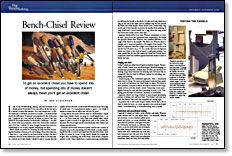Bench-Chisel Review
To get an excellent chisel you have to spend lots of money, but spending lots of money doesn't always mean you'll get an excellent chisel
Synopsis: The range of chisel prices prompted Rex Alexander to review 17 high-end and low-end models, including Japanese chisels. He limited his evaluation to 1/2-in bench chisels, also called bevel chisels or cabinetmaker’s chisels, and did controlled and uncontrolled testing at his bench and at a lab to gauge how well they held an edge with repeated pounding. He talks about how they are made, discusses different types of handle fittings (such as socket and tang chisels), and explains differences between hand- and machine-forged steel. Alexander tested the chisels on white oak, curly maple, and cedar, and he reports on which tools performed best. The results may surprise you.
Look in any woodworking catalog, and you’re bound to see chisels priced from $29.95 for a set of four all the way up to almost 10 times that amount. For a very simple tool—a chisel is really just a steel blade attached to a handle—can there be that much of a difference? Frustrated and perplexed by this wide price gap, I gathered up a tool roll full of chisels to answer that very question. For several months I worked with 17 different -in. chisels—some with fancy handles, others that looked like sculpture and a few that I wished I’d never bought because they were uncomfortable to use or they required sharpening too often.
Bench chisels are perfect for cleaning out deep mortises, for paring the shoulders of tenons or for dovetailing. More often than not, I reach for a -in. chisel for my bench work, so that’s the size I evaluated. If you’re in the market for a new chisel or, for that matter, a whole set of new chisels, I think it’s safe to assume that the quality (or lack thereof) of one brand will extend across the range of chisel sizes. If a manufacturer makes a good -in. chisel, it stands to reason that its other sizes will also be good. Going also by the name of bevel chisel or cabinetmaker’s chisel, these long, slender chisels can range in overall length from in. to in. Each chisel has a thin blade with beveled sides, which makes it easier to work it in tight places such as the corner of a dovetail. The bevel angle and the total thickness of the blades vary among manufacturers.
A handle can be made of wood or plastic and fits into a socket or around a tang on the noncutting end of the blade. A socket chisel’s handle fits into a conical cup forged into the end of the blade, kind of like ice cream in a cone. A tang chisel’s handle fits around the forged, thin, noncutting end of the blade, kind of like a Popsicle around a stick. Some chisels have a socket-and-tang combination for affixing the handle to the blade. A socket-and-tang chisel has a tang on the end of the blade and an auxiliary ring that fits around the blade end of the handle. Many chisels have a metal strike ring on the end of their handles to protect the handles from splitting. A tang chisel with a wood handle has a ring where the tang meets the wood and a strike on the other end.
Japanese chisels differ from their Western counterparts in several ways.
From Fine Woodworking #139
For the full article, download the PDF below:
Fine Woodworking Recommended Products

Marking knife: Hock Double-Bevel Violin Knife, 3/4 in.

Starrett 12-in. combination square

Tite-Mark Marking Gauge























Log in or create an account to post a comment.
Sign up Log in